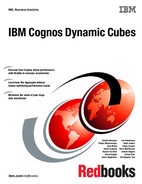252 IBM Cognos Dynamic Cubes
7. If your table names do not match those that are used by the prior environment, remap
each measure and query item that uses those table names.
8. Right-click the cube in the Project Explorer, and select Publish.
9. Complete the publish wizard.
9.2.2 Development
The development environment is the primary environment used by cube modelers and report
developers to design the cube and to create reports. The modelers use the defined business
requirements to create a cube model to satisfy those requirements. The cube should be
modeled in an iterative fashion by defining the cube with a small number of hierarchies and
measures, and testing them to make sure that they are correct before gradually expanding the
cube to include more dimensions and more complex objects. If necessary, add security filters
and views into the model.
When the cube is ready for deployment, the modelers might want to take advantage of the
quick-deploy feature of Cognos Cube Designer to publish the cube, add the cube to the
dispatcher, set the access account, and even start the cube. In this environment, users
generally have more authority, and using the quick deploy feature to handle some of the
administrative tasks can speed the iterative workflow.
After the cube starts, report authors create sanity reports to validate that the basic
functionality of the cube is correct. If any of the dimensions, hierarchies, measures, or other
components do not appear to be correct, the cube model returns to the modeler to
investigate. This cycle repeats until the cube is satisfactory and the reports against it return
the expected data. When this point is reached, the dynamic cube is transferred to the test
environment by using one of the methods described in 9.2.1, “Mechanisms for moving
dynamic cubes” on page 248.
If issues exist in the subsequent environments, work shifts back into the development
environment for further investigation or updates. Additionally, if there are any in-database
aggregate recommendations from the Optimize phase of the subsequent environments,
those tables must be created and modeled as aggregate cubes in the development
environment.
9.2.3 Test
When the dynamic cube is transferred into the test environment, a more comprehensive set of
reports gets created and executed. If any of the dimensions, hierarchies, measures, or other
components do not appear to be correct, the cube model returns to the modeler to
investigate. After the testers in the test environment are satisfied that the cube is modeled
correctly, they can start analyzing the performance of the reports.
If the performance of the reports is not acceptable, then the tester might adjust some of the
tuning parameters on the cube or server. Another option is to enable workload logging, run
the query workload, and run the Aggregate Advisor to obtain aggregate recommendations.
In-memory aggregates can be applied immediately; in-database aggregates require some
additional work. For any in-database recommendations, a DBA will need to create the tables
in both the development and test environments. The development environment needs the
in-database aggregates, because the modeler will use those tables to model the aggregate
cube in the Cognos Cube Designer. After the aggregate cubes are added to the model in the
development environment and the cube model is cycled back to the test environment, more
performance testing occurs.
..................Content has been hidden....................
You can't read the all page of ebook, please click here login for view all page.
